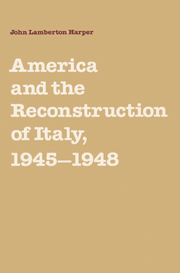Book contents
- Frontmatter
- Contents
- Preface
- Frequently used abbreviations
- 1 Introduction and overview
- 2 Wartime diplomacy
- 3 Liberation and transition
- 4 The advent of De Gasperi
- 5 Clayton at bay
- 6 Corbino, UNRRA, and the crisis of the liberal line
- 7 The emergency response
- 8 The “whirlwind of disintegration”
- 9 The dilemmas of deflation
- 10 Conclusion: the Marshall Plan and after
- Notes
- Bibliography
- Index
3 - Liberation and transition
Published online by Cambridge University Press: 11 September 2009
- Frontmatter
- Contents
- Preface
- Frequently used abbreviations
- 1 Introduction and overview
- 2 Wartime diplomacy
- 3 Liberation and transition
- 4 The advent of De Gasperi
- 5 Clayton at bay
- 6 Corbino, UNRRA, and the crisis of the liberal line
- 7 The emergency response
- 8 The “whirlwind of disintegration”
- 9 The dilemmas of deflation
- 10 Conclusion: the Marshall Plan and after
- Notes
- Bibliography
- Index
Summary
INTRODUCTION
Allied officials greeted the formation of the first postwar Italian government on June 21, 1945, with cautious optimism and relief. It contained prominent members of the Northern CLN (CLNAI), including Prime Minister Ferruccio Parri, a resistance hero and leader of the Action Party. But the situation remained tense and potentially explosive. Armed partisans roamed the countryside, settling scores with Fascists and personal enemies. Communists and Socialists held key ministerial posts, and Parri's political abilities were at best an unknown quantity. Northern factories stood idle, and inflationary forces from the South threatened to penetrate the newly liberated areas.
Austere and incorruptible, Ferruccio Parri epitomized for many the nobility and promise of the anti-Fascist resistance. Novelist Carlo Levi called Parri a “chyrsanthemum in the dunghill” of early postwar politics. Another admirer, OSS Bern Chief Allen Dulles, was more prescient when he observed in June 1945, “As a politician he is probably a novice and I question whether he will be ruthless enough to grapple with the difficult situation facing him.” Parri was a compromise among the major political forces and lacked the political base and personal dynamism to impose his will on the likes of Nenni, Togliatti, and De Gasperi. Economic problems festered throughout his tenure, and Parri himself became a helpless bystander as wartime unity deteriorated into partisan strife. In addition the United States did not play an active role in Italy during the early stages of postwar recovery as the following chapter shows.
- Type
- Chapter
- Information
- America and the Reconstruction of Italy, 1945–1948 , pp. 37 - 57Publisher: Cambridge University PressPrint publication year: 1986



